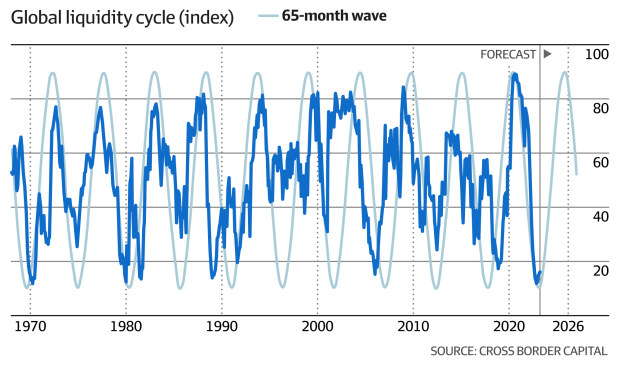As a result of the BTFP, the Fed’s balance sheet assets grew by $US297 billion ($442 billion) last week as commercial banks pledged securities in exchange for equivalent funding that translated into the liquidity flood.
In turn, bitcoin surged 40 per cent from around $US20,200 on March 10 the day of SVB’s collapse to top $US28,000 on Monday.
The latest surge is as traders react to a new Fed pledge to supply more US dollar liquidity to the global financial system via more regular funding swap lines with the Bank of Canada, Bank of England, Bank of Japan, European Central Bank, and Swiss National Bank.
Bitcoin’s price drivers
Bitcoin’s price action over the last week has also decisively broken its reputation as a barometer of risk appetite correlated to high-growth equities.
On Friday, the tech-heavy Nasdaq index sunk, while bitcoin surged above $US27,000. This shows bitcoin’s intrinsic value is as a barometer of liquidity, not risk appetite.
It follows that risk appetite, banking crises, and inverted yield curves are all symptoms of liquidity cycle stages and if you want to know when to buy and sell the number one cryptocurrency, you should follow the liquidity cycle above all else.
That’s easier said than done. However, British macroeconomist and bond market veteran Michael Howell boasts he has built data models to measure liquidity in the financial system as a guide to future asset returns.
Howell is the founder of $US1 billion multi-asset asset manager Cross Border Capital, and defines liquidity as the total sum of wholesale cash and credit passing through world financial markets, as opposed to retail money supply.
Cross Border Capital’s data produces a global liquidity index by measuring data across 90 national economies and Howell says the latest liquidity cycle has bottomed with scope for a new peak around 2025 or 2026. The macroeconomist also says historic data shows liquidity cycles work on regular five to six-year intervals as central bankers meet their mandates.

Cross Border Capital’s global liquidity index uses data from 90 countries to plot and forecast liquidity cycles in financial markets. Cross Border Capital
Bitcoin is the best barometer of liquidity today, according to Howell, and if you accept his research on face value, more liquidity is bullish for bitcoin for the next few years.
Bitcoin maximalists and libertarians also insist disciples of their financial revolution must be their own bankers.
However, tens of millions of retail traders are thought to rely on centralised exchanges like Coinbase or local Australian operators to hold deposits on their behalf.
So, will the moral hazard of guaranteeing banks’ deposits extend to deposits at licensed crypto exchanges if they also collapse on bad investment bets? There are already plans for capital adequacy and custody requirements for exchanges in Australia, with the creeping nationalisation of financial markets perhaps spilling over to the crazy crypto ecosystem before we know it.




